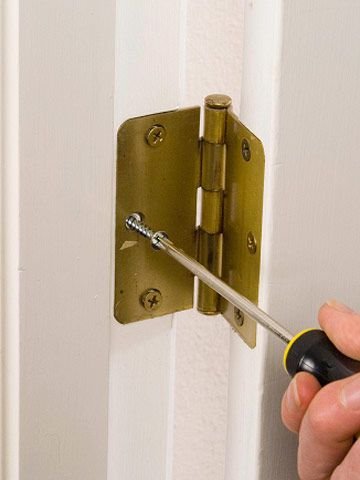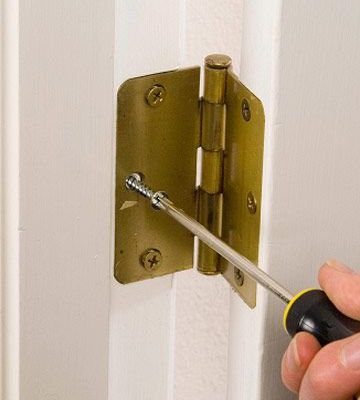
Let me explain: a hinge is the backbone of your door’s movement, the unsung hero that makes opening and closing possible. If your exterior door—be it a classic wood Craftsman, a steel security door, or even a modern fiberglass entry—starts to feel wobbly at the hinges, it’s not just annoying. Left unchecked, it can mess with your home’s security, insulation, and even energy bills. Today, we’ll dig into why this happens, how you can spot it, and what you need to do to fix it for good.
What Does “Play” in a Door Hinge Actually Mean?
When you hear someone talk about a hinge having “too much play,” they’re just saying there’s too much movement where there shouldn’t be. Imagine a door that jiggles up and down, or moves left and right even when it’s closed. That slop, that wiggle space, is called “play.”
You might notice this first as a draft coming in around the edge of the door, or a latch that doesn’t seem to line up. Sometimes, you’ll even hear a metallic click when the door rocks on the hinge pins. Here’s the thing: a tiny bit of play is normal—hinges need some clearance to swing. But excessive play starts small and grows worse over time. The more the hinge wears out, the more likely you are to have door alignment problems, difficulty locking up, or even full-on sagging that keeps the door from closing at all.
Think of this as similar to car parts wearing out. Just like your brakes or tires can wear thin from years of use, door hinges can develop too much slack from constant opening, closing, and even slamming. It’s not a one-time problem—play in a hinge usually points to wear and tear happening slowly over months or even years.
Common Causes of Exterior Door Hinge Play
You might be wondering, “How does a sturdy steel hinge get worn down enough to feel loose?” The answer is usually a mix of a few culprits:
- Loose screws: Over time, the screws holding the hinge to the door or the frame can back themselves out. Wood expands and contracts, and people bump or slam doors. Eventually, those screws might not grip tightly—and that can add unwanted movement to your hinge.
- Worn hinge pins: The pin in the middle of your hinge takes the brunt of the load every day. Years of use—or exposure to weather and moisture—can wear down that pin and the holes it sits in, creating a bigger gap than intended.
- Damaged or warped hinge leaves: Hinges are usually made of steel or brass, but even metal can bend, warp, or corrode. If the hinge leaves (those flat plates) bend, the whole system loosens up.
- Deteriorating door frame: Exterior doors take a beating from the weather. If water gets into the wood around your hinges, it can rot, swell, or shrink. Suddenly, there’s nothing solid for your screws or hinges to hold onto.
Sometimes, it’s a combination—a worn hinge pin plus a rotting frame equals a wobbly disaster. If you’re dealing with a newer metal or fiberglass door, sometimes the factory screws are too short to anchor deeply in the frame. That’s a shortcut that can come back to bite.
How to Diagnose Too Much Hinge Play
Honestly, it doesn’t take a pro to figure out if your exterior door hinge has too much play. Here’s how you can check, step by step:
- Open the door halfway. Gently lift up on the handle. If you see the door move up and down, you’ve probably got play in the hinges or the screws.
- Wiggle the door back and forth. Does the entire door shift left and right at the hinge side? That usually means your hinge leaves have worn out or bent.
- Check the screws. Take a close look at all the screws in your hinges. Are some missing or loose? If you try to tighten them, do they just spin without grabbing anything in the wood?
- Look for visible gaps. With the door closed, check for any visible light around the hinges or between the door and the frame.
If your hinge feels loose no matter what you do, it might be time to consider a reset—a full repair rather than just a quick tighten.
Don’t forget to listen as well as look. If you hear popping, squeaking, or clunking when the door opens and closes, that’s another classic sign something’s off with your hinges.
Why Exterior Door Hinge Play Matters
It might seem minor, but too much play in your exterior door hinge can trigger a whole chain reaction of problems. First off, a loose hinge makes the door sag. You might notice it scraping the floor or not closing all the way. That’s more than a cosmetic issue—it’s a security risk, especially if you have a deadbolt that can’t line up with the strike plate anymore.
There’s also the weather factor. A wobbly door may let cold air, rain, or even pests sneak into your home. Over time, that drives up your heating and cooling bills and can even cause water damage around the threshold or frame. And let’s be honest—nothing kills your curb appeal faster than a front door that looks crooked or gaps that invite drafts.
If you let this issue go, the problems only get worse. Eventually, the hinge can tear out of the frame completely, leaving you with an emergency on your hands (and probably a hefty repair bill). Staying on top of hinge play isn’t just about keeping your door swinging smoothly—it’s about protecting your home from the inside out.
How to Fix a Door Hinge With Too Much Play
Ready to roll up your sleeves? Fixing too much play in an exterior door hinge is a bit like syncing a finicky remote: troubleshooting, then dialing in the right solution. Here’s the step-by-step approach most pros (and handy homeowners) swear by:
- Tighten loose screws with a screwdriver. If the screws no longer grip, replace them with longer screws that can bite into solid wood (3-inch screws are a classic trick).
- Replace worn hinge pins. If your hinge pin looks thin, rusty, or grooved, pop it out (tap it up with a nail and hammer) and bring it to the hardware store for a match.
- Repair stripped holes. If screws spin in place, fill the holes with wood glue and toothpicks (or use a wooden dowel), then drive a new screw when the glue dries. For hollow metal doors, special anchor kits are available.
- Replace the hinge entirely if it’s bent, cracked, or corroded. Match the new hinge’s size, screw pattern, and finish to your existing setup.
- Check door alignment. After repair, close the door gently and make sure it latches smoothly and doesn’t drag.
If the door frame is rotten or badly damaged, you might need a more serious reset—think patching the wood, adding framing, or calling in a pro for a bigger repair.
Should I Upgrade to Heavy-Duty or Specialty Hinges?
You might be tempted to just swap in another cheap hinge and call it a day. But if your door gets heavy use—kids running in and out, frequent slams, or even a battery-powered smart lock adding extra weight—a stronger hinge might be worth it.
- Ball bearing hinges are tougher and quieter, perfect for heavy doors or homes with lots of traffic.
- Security hinges include extra features like non-removable pins, boosting protection for exterior entries.
- Adjustable hinges can help if your frame or door setup is less than perfect, letting you tweak alignment without starting from scratch.
Think of this like picking between a universal TV remote and the brand-specific original. Sometimes, the universal works fine. But in high-use or tricky setups, something built tougher (or matched to your exact door) usually lasts longer and gives fewer headaches.
When to Call a Pro for Door Hinge Problems
Here’s the thing: not every hinge problem is a DIY fix. If the door won’t close at all, the frame is split, or you’re dealing with a metal-clad security door, a pro might be your best bet. They have the tools—and the experience—to reset hinges, replace big sections of rotten wood, or install upgraded hardware in a jiffy.
You might also want expert help if you’ve tried all the tricks (longer screws, new hinges, filling holes) and your door still sags or sticks. Sometimes, hidden framing issues or subtle alignment problems are at play. A good contractor can spot and fix those fast—saving you time, cash, and frustration.
If you’re ever in doubt, a quick phone call to a trusted local pro can help you figure out if your hinge fix is a quick DIY or needs a deeper troubleshooting reset.
Wrapping Up: Keep Your Door—and Your Home—Solid
A loose exterior door hinge is one of those problems that starts small and snowballs if you don’t deal with it early. Too much play leads to sagging, drafts, and security headaches, but it’s usually fixable with a careful check, a few tools, and the right parts. Whether you sync things up with fresh screws and a new hinge or call in a pro for a reset, keeping your hinges tight keeps your home safe and comfortable.
Next time your door gives you that telltale wiggle—or just doesn’t feel right—don’t let it slide. A few minutes of troubleshooting now can save you from a world of trouble (and a lot of chilly drafts) down the road.
